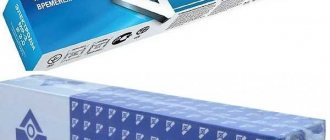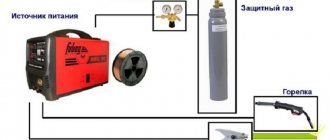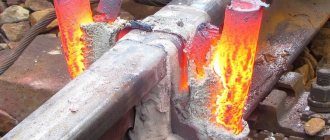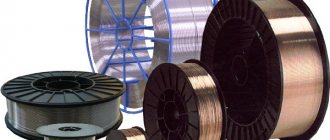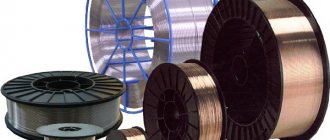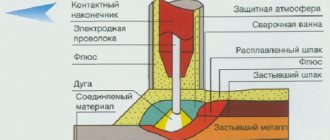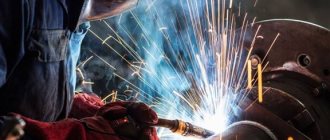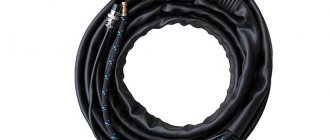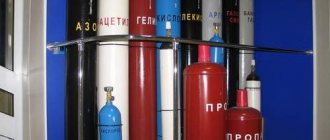What the article is about:
Choosing a shielding gas for welding: helium, argon, carbon dioxide
Oxygen has a negative effect on the weld pool, which can reduce the resistance of the weld to corrosion processes. In addition, as a result, its strength qualities will decrease.
As a result, pores may appear on the seam. Thanks to the gas flow, the weld pool has a protective shell that protects it from dangerous environmental influences. Moreover, the shielding gas provides the weld with protection from moisture and oxidation.
The quality of the weld depends largely on the shielding gas. This is especially true for such types of welding as MAG - Metal Active Gas, MIG - Metal Inert Gas and TIG - Tungsten Inert Gas.
Shielding gases and their types
Inert protective gases do not have the property of dissolving or interacting with heated metal. Used when welding magnesium, titanium, aluminum. For example, nitrogen, argon, helium.
Active gases, on the contrary, interact with the metal and are able to dissolve in it. For example, oxygen, carbon dioxide, nitrogen, hydrogen.
Argon is a non-toxic and explosive gas, tasteless and odorless. Designed for argon-arc TIG welding for all materials, as well as MIG welding of non-ferrous metals. Argon can also be used for welding refractory and chemically active metals.
When using argon, it is possible to obtain a narrow and deep seam. This type of gas is transported and stored in special cylinders, which are decorated in gray and have a green inscription.
Scope of application for semi-automatic machines
When electric arc welding with a semi-automatic device, a cloud of shielding gas must be prevented from contacting the molten metal in the weld pool with oxygen, nitrogen and water vapor contained in the atmospheric air. Such contact leads to the formation of oxides and other undesirable compounds that deteriorate the quality of the weld, leading to the formation of porosity, cracks and other defects. A cloud of protective gas displaces air from the working area and reliably closes it. Gas must be constantly supplied to the work area.
Shielded gas arc welding is used for virtually all metals and their alloys - from ferrous to non-ferrous, light metals such as aluminum or magnesium, and rare earths.
This technology is used both in industrial enterprises, in semi-automatic and automatic units, and in small repair shops. Recently, equipment has become available to home craftsmen.
Helium for welding
Helium is a non-poisonous type of protective gas; it is odorless, tasteless and colorless. Helium is used for argon-arc TIG welding of non-ferrous metals, aluminum, etc. This option is also suitable for welding on ceiling surfaces. In the process, it is possible to obtain a wide weld with wetted edges.
Helium is often used in addition to argon. It is designed for joining magnesium and aluminum alloys, as well as active and chemically pure metals. This gas is found in brown cylinders and has a white lettering.
Carbon dioxide is suitable for welding thicker metals. In this case, you need to be prepared for the formation of splashes during welding. You can only work using a short arc. The gas is used for MAG flux cored wire welding and semi-automatic MAG short arc welding. Available for sale in black cylinders with yellow inscription.
Gas composition
When preparing gas mixtures, it is necessary to strictly observe the standardized proportions. Even a small violation of the specified composition can lead to a significant change in properties and the appearance of defects.
The most commonly used mixtures are:
- K2: Ar 82% CO2 18%;
- K3.1: Ar 92%, CO2 6% O2 2%;
- K3.2: Ar 86%, CO2 12% O2 2%;
- K3.3: Ar 78%, CO2 20% CO2 2%;
- NP1: He 85%, Ar 13% CO2 1.5%;
- NP3: He 38%, Ar 60% CO2 2%;
- NP2: He 55%, Ar 43% CO2 2%.
Parameters of shielding gases for welding work.
Why are shielding gases needed when welding and cutting?
During welding, the metal is heated to its melting point. In this state, it is susceptible to the influence of oxygen, nitrogen and water vapor contained in the air. As a result of contact, undesirable chemical compounds are formed that impair the strength and durability of the seam, leading to the appearance of defects. A cloud of shielding gas prevents this contact and maintains the high quality of the weld .
Gases complementing welding mixtures
Thanks to such welding gases, it is possible to make a better quality weld and reduce metal spattering.
For MIG MAG welding, oxygen is used as an additional component. With its help, you can create a wide seam, while the penetration of the metal is insignificant.
Hydrogen is used to bond austenitic stainless steel. The process creates a wide seam with deep penetration.
Nitrogen is intended more to protect the weld from rust than as a protection.
It is very important to choose the right shielding gas. Not only the quality and geometry of the weld directly depends on this. This way, it will be easier to correct defects and process the seam at the end.
Essence of the process
What is gas shielded welding? It requires the following equipment:
- semi-automatic welding;
- gas cylinder;
- welding torch;
- gas supply hose combined with electrical cable and burner cooling system.
Other auxiliary equipment may also be used.
Both an outdated welding rectifier and a modern inverter can be used as a power source for welding performed in shielding gases. The apparatus includes a mechanism for feeding welding wire, which serves as a filler material.
The electrode is a welding wire to which voltage is applied . An electric arc is ignited between its tip and the metal of the workpiece. Its heat melts the metal, forming a weld pool. A protective gas is supplied through the burner nozzle, protecting the working area from contact with oxygen, nitrogen and air water vapor.
When the torch moves, the weld pool moves after the arc, the molten metal, cooling and crystallizing, forms a seam. The productivity of the process several times exceeds the general machine-building enlarged time standards allotted for manual arc welding.
Noble gases
Inert gases are gases that are not capable of chemical reactions and are practically insoluble in metals. These are monatomic gases, the atoms of which have outer electron shells filled with electrons, which determines their chemical inertness. Among the inert gases used for welding are argon, helium and their mixtures.
Argon grade A is recommended for welding and melting active and rare metals (titanium, zirconium and niobium) and alloys based on them, as well as for welding particularly critical products from other materials at the final stages of manufacturing.
Argon grade B is intended for welding and melting with consumable and non-consumable tungsten electrodes of alloys based on aluminum and magnesium, as well as other alloys that are sensitive to impurities of gases soluble in the metal.
Argon grade B is recommended for welding and melting chromium-nickel corrosion-resistant and heat-resistant alloys, alloy steels of various grades and pure aluminum.
Helium , like argon, is chemically inert, but unlike it, it is much lighter. Helium is lighter than air, which complicates the protection of the weld pool and requires greater consumption of shielding gas. Compared to argon, helium provides more intense heating of the welding zone, which is caused by a large gradient of voltage drop in the arc. Helium is supplied according to MRTU 51-77-66 in two grades - high-purity helium and technical helium.
Inert gas mixtures:
Argon and helium. Having a higher density than helium, such mixtures better protect the metal of the weld pool from air. An inert gas mixture consisting of 70 vol.% argon and 30 vol.% helium has especially good protective properties. The density of such a mixture is close to the density of air. For welding chemically active metals, an inert mixture containing 60-65 vol. is used. % helium, and the rest is argon. Inert gas mixtures, although noticeably more expensive than argon, surpass it in the intensity of heat release from the electric arc in the welding zone. This is essential when welding metals with high thermal conductivity.
Mixtures of inert and active gases are increasingly used in consumable electrode welding of steels of various classes due to their technological advantages:
- lower intensity of chemical action on the metal of the weld pool compared to active gases;
- high stability of the arc process;
- favorable nature of the transfer of electrode metal through the arc.
Argon and oxygen (another oxidizing gas). significantly increases the stability of arc combustion and improves the quality of weld formation. The presence of oxygen in the arc atmosphere promotes finer droplet transfer of the electrode metal. This is due to the surface-active effect of oxygen on iron and its alloys. By dissolving in liquid metal and accumulating mainly on the surface, oxygen significantly reduces its surface tension. As a result, the formation of individual drops of metal is facilitated, and their size is reduced. Therefore, for welding steel, not pure argon is used, but mixtures with oxygen and carbon dioxide Ar-O2, Ar-CO2, Ar-CO2-O2.
An argon-hydrogen mixture (up to 20 vol.%H2) is used for microplasma welding. The presence of hydrogen in the mixture ensures compression of the plasma column, making it sharper and more concentrated. In addition, hydrogen creates a reducing atmosphere necessary in some cases in the welding zone.
The most popular methods
Gas welding most often uses the following types of technology:
Left
Does not require high qualifications. Used for welding workpieces of small thickness and low melting point.
Right
Used for alloys with high thermal conductivity and for workpieces from 3 to 16 millimeters. Due to the protective effect of the burner torch, the quality of the seam increases.
Using a through roller
The method involves moving a torch from melting the top edge to the bottom and placing a layer of metal on it.
Using baths
Used for joining thin-sheet workpieces. It involves the consistent creation of miniature weld pools along the seam line. The edges of the tubs overlap each other, creating a continuous seam line.
Popular gas welding technologies.
Multilayer
Used to create particularly critical connections of large thickness. Requires careful cutting of edges. Characterized by high consumption of welding gases. Each subsequent pass compacts the suture material formed during the previous passes.
Active gases
Active shielding gases are gases that can protect the welding zone from air access and at the same time chemically react with the metal being welded or physically dissolve in it. When arc welding steel, carbon dioxide is used as a protective medium. Due to its chemical activity towards tungsten, welding in this gas is carried out only with a consumable electrode. The use of carbon dioxide provides reliable protection of the welding zone from contact with air and prevents nitriding of the weld metal. Carbon dioxide has an oxidizing and also carburizing effect on the metal of the weld pool. Of the alloying elements in the bath, aluminum, titanium and zirconium are most strongly oxidized; silicon, manganese, chromium, vanadium, etc. are less intensely oxidized.
Previously, an obstacle to the use of carbon dioxide as a protective medium was the pores in the joints. The pores were caused by boiling of the solidifying metal of the weld pool due to the release of CO due to its insufficient deoxidation. The use of welding wires with a high silicon content eliminated this drawback, which made it possible to widely use carbon dioxide in welding production.
Finds industrial application in welding low-carbon and low-alloy structural steels.
Appendix YES (reference)
Information on the compliance of reference international standards with reference national standards of the Russian Federation (and interstate standards acting as such)
Table DA.1
| Designation of the reference international standard | Degree of compliance | Designation and name of the corresponding national standard |
| ISO 80000-1:2009 | — | * |
| *There is no corresponding national standard. Before its approval, it is recommended to use the Russian translation of this international standard. A translation of this international standard is available from the National Agency for Control and Welding (NAKS). | ||
Advantages
The technology has the following advantages:
- cheap equipment;
- ease of adjusting the burner power and heating the workpiece;
- no need for power supply.
Gas burner operation diagram.
The disadvantages of the technology include:
- slow heating of the workpiece;
- large energy losses;
- automation difficulties.
It is also difficult to boil thick workpieces with gas. Propane and acetylene used for work are flammable and require strict compliance with safety requirements

